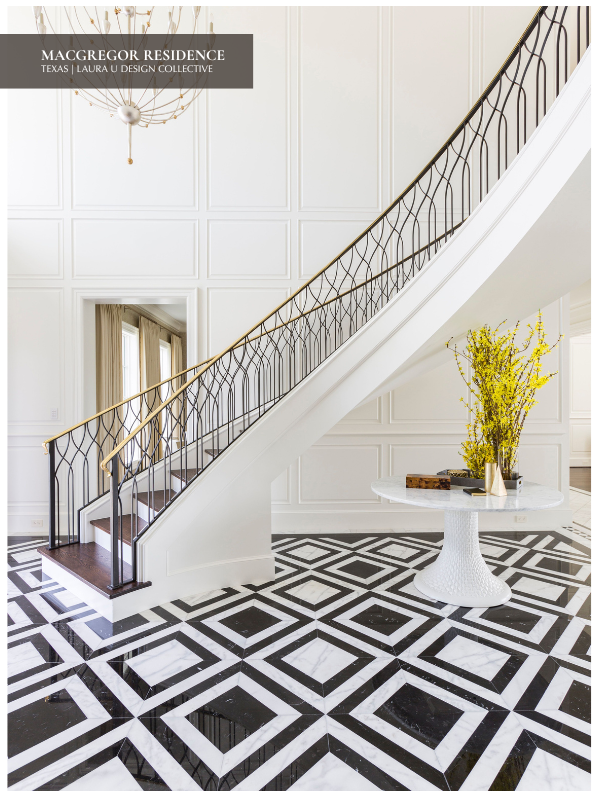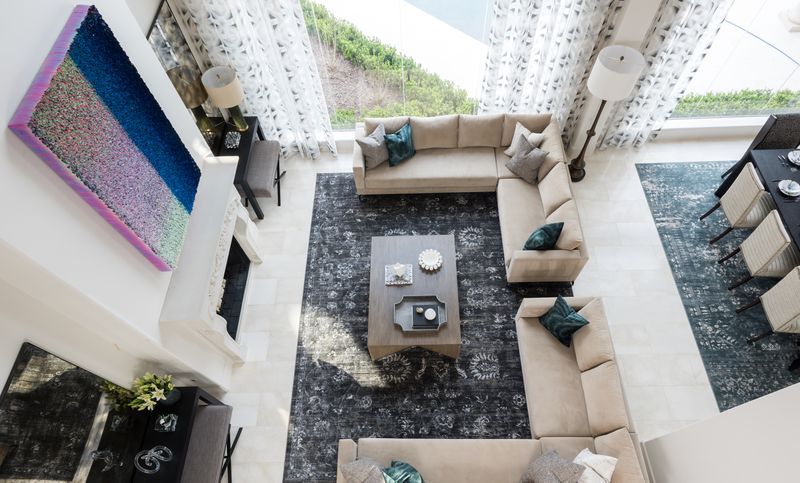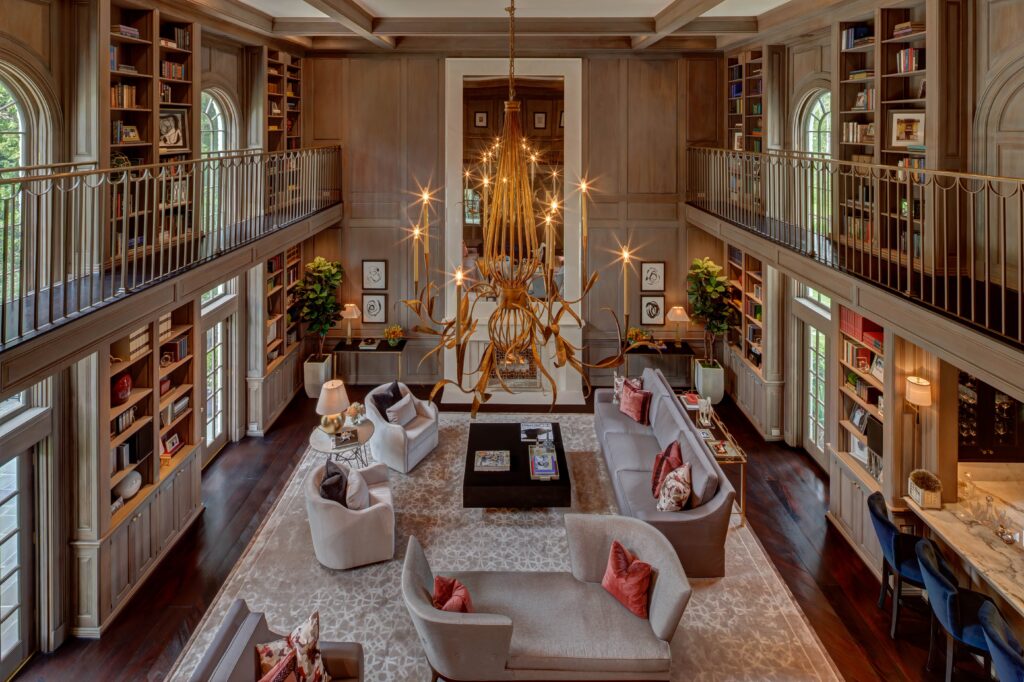One of the most sought-after looks, transitional interior design has been popular for decades. As a response to the bare minimalism that Mid-Century Modern spaces tend to embrace, transitional styles are warmer, more collected. They marry the traditional with the modern in an unexpected way that looks effortlessly timeless.
Many of our clients will point to a transitional interior for design inspiration. There are many wonderful interpretations of this style. We’re also detailing the looks of two of our favorite designers who produce stunning transitional spaces: Victoria Hagan and Thomas Pheasant.
WHAT IS TRANSITIONAL INTERIOR DESIGN?
Transitional interior design is a mixture of the traditional and modern styles. Bringing together pieces from various design styles creates a singular design that updates the classics with a cohesive, modern feel. It balances luxury with comfort, masculine with feminine, and antiques with new pieces.
These contradictions create a sense of tension in a space, much like black and white battle and blend so well together. The result is simple sophistication. Rather than prioritize form over function, transitional interior design emphasizes comfort and softness. Here are the key components of a transitional interior:
- Comfortable, functional furnishings
- Neutral color palettes, like gray and cream
- Minimal accessories (pops of color OK!)
- Soft, high-performing fabrics
- Natural textiles and materials
- A blend of masculine and feminine styles
Transitional interior design bridges the gap between traditional and modern without feeling too stuffy or stark. Perfect for growing families, this style is practical, using larger scale furnishings in plush, high performance upholstery and focusing on neutrals.

We love the combination of these upholstered, high-backed chairs with these clean-lined sofas in this formal sitting room.

KEYS TO THE TRANSITIONAL COLOR PALETTE
A transitional design color palette is serene and soothing. Whites, creams, grays, and tans create a clean backdrop and ground the design. Adding deep blues, rich browns, and verdant pops of green add depth and activate the design. The space should feel soft and subtle. You won’t find black walls in a transitional interior. The focus on neutral colors allows designers to focus more on texture and layering, key components of this style.

The rug and wood details add texture and warmth to this cool, modern entryway.
TRANSITIONAL INTERIOR DESIGN ACCESSORIES – THINK FUNCTIONALITY
For transitional interiors, you must select accessories that create visual interest, tell your story, and fit your lifestyle. The goal here is to incorporate meaningful pieces that have a purpose. Think area rugs, decorative pillows, plants, and trays. Of course, you can never go wrong with layering in some metallic pieces. A statement light fixture, side table, or a piece of sculptural art give the room a sophisticated, glam feel. We love the mix of cozy fabrics with chic metallic accessories.

USING AND LAYERING TEXTILES
Instead of using color to create contrast, transitional design uses texture and tone. Fabrics like suede, chenille, and leather are common. Other textural elements like wood, glass, and rattan, add interest without taking away from the rest of the design.
There are no strict rules to designing a unique space, but transitional interiors typically rely more on layering than colorful patterns. For instance, you may have suede against leather against wood against glass, all of which are within the same color family. If all were in a lovely shade of cream, they would be perfect in a transitional living room. Pops of color do come in, but more as decorative accents, like the pillows and art pieces below.

A sleek low profile sofa or banquette paired with upholstered dining chairs makes a warm and welcoming dining space.
SELECTING TRANSITIONAL FURNISHINGS
Transitional furnishings maintain the classic lines of modern styles, but are updated with sumptuous fabrics. They rely on soft lines and curves to make a statement instead of extra embellishments. Unexpected touches like lacquered finishes or graphic fabrics make them feel fresh and modern.
Traditional wood furniture and antiques play a central role in traditional interior design. Pairing a classic statement piece like a wood dining table with curved dining chairs is a gorgeous interpretation of the transitional combination.
Oftentimes furniture is grouped together to create conversation zones. Large sofas and roomy accent chairs make the room feel intimate and cozy. Furniture grounds the design, creating a useful focal point without interrupting the flow.

The textural fabric on the bar stools adds a beautiful touch of subtle color to her kitchen design.
KEY TRANSITIONAL INTERIOR DESIGNERS
The beauty of transitional design is that you aren’t limited to one certain design style. It blends styles that are client-specific and unique to you. Here are a few designers I love who are practicing this style right now.
VICTORIA HAGAN
We love how Victoria Hagan uses materials, refined color palettes, and pieces with striking silhouettes to create her transitional interiors. Her designs are grounded in a neutral color palette but touches of rich, bold color add personality and a modern touch. Intimate seating areas of traditional style sofas paired with unique accent chairs make for warm and welcoming spaces. Her designs are relaxed and comfortable, yet luxurious and timeless.

THOMAS PHEASANT
Thomas Pheasant does a stunning job of creating simple, elegant transitional interiors. We love the way he makes traditional elements like ceiling designs and millwork feel fresh by painting them white. He combines curved and straight lines to create beautiful lines of symmetry that gently move your eye around the room.
And his use of neutral color palettes is anything but boring! He proves that neutral colors are actually quite statement making.

A calm, warm color palette of cream, beige, and dusty rose create a relaxing atmosphere perfect for this master suite.
THE BEAUTY OF TRANSITIONAL DESIGN
We may be a little biased, but our team does the transitional design style very well. Since transitional design focuses on blending traditional with modern, understanding our clients’ family history is an essential part of our design process. Layering family heirlooms or memorable pieces with modern ones is what creates a timeless, collected interior that tells your unique story.

The modern art piece (not pictured) and decor objects add an eye catching element to this warm, welcoming family room.
CREEKSIDE RESIDENCE

In this Creekside residence, we wove our client’s collection of antiques in with clean-lined sofas and chairs. We chose a neutral color palette of whites and creams to complement the exposed brick and traditional hardwood floors. Cobalt blue accents create a serene and relaxing space while adding visual depth. Metallic accessories, chic light fixtures, and colorful art infuse personality into the design without taking your focus off the furnishings.
Similarly, our University Place project suits the transitional design style perfectly. The tailored navy leather chairs paired with a rustic wood table are a classic transitional pairing—modern in silhouette, traditional in materiality. The tiered pendant lights and tonal wallpaper layer in elegance without visual clutter.

Bright, graphic wallpaper, intriguing fabric, hardwood floors, and a natural light fixtures give this dining room a casual, but luxe feel.
MACGREGOR HOME

Our client had a fabulous collection of textiles and fabrics that we used throughout her MacGregor home. Bold, colorful upholstery on classic style chairs in the dining room and kitchen give the space a modern feel. Touches of black and brown add contrast to the design’s white color palette. Accents of wood, natural stone and brick add warmth and depth. Layered metallic accessories give the design a glam, feminine feel and soften the strong, masculine lines.

These white table top accessories add a collected, worldly feel to this stunning entry way.
WHITEHILL ESTATE
For our Whitehill Estate project, our client’s wanted an interior design that modernized the home’s traditional architecture. Antique accessories and traditional ironwork on the stairs feel fresh and timeless thanks to the black and white color palette. Colorful accessories soften the crisp lines of the furniture and add dimension. I love the richness the touches of navy and green add to this relaxed, yet elegant space. Cozy seating arrangements in the living room and family room provide plenty of seating without interrupting the flow.

The intimate seating arrangements, the gorgeous wood paneling, the modern chandelier…We can’t decide what we love most about this space!
WILLOWICK HOME
This Willowick home needed a complete renovation, but the open concept floor plan allowed us to turn it into something classic and chic. The double height library with wood paneling and corridor overlooking the gardens gave the home a very traditional feel.

By refinishing the wood panels and turning the corridor into an art gallery, the space took on a fresh, modern feel. Updated crystal chandeliers and striking marble floors and counters pay homage to traditional design elements in a Classically Current way. Vibrant art and metallic accessories add a feminine touch to the more masculine and geometric designs while balancing the traditional features.

We love how our client’s collection of modern art pops against the black walls. It’s a modern twist on creating a museum like experience for displaying your art at home.
TRANSITIONAL DESIGN IS THE PERFECT MIDDLE GROUND
Transitional design is about blending opposing styles in a way that matches your personality. It’s perfect for those whose love elements of both traditional and modern decor. With transitional design, you aren’t tied to one design style. You have the freedom to incorporate pieces from different design periods to create an interior design that’s truly unique to you.

